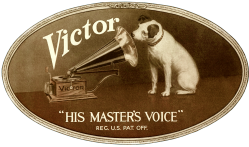The Victor-Victrola Page
Section Three: Dating your Victor Phonograph
DON'T PAY ATTENTION TO PRINTED OR STAMPED DATES APPEARING ON YOUR MACHINE! You've probably found a metal tag on your Victor Talking Machine that says "1904" and/or "1906" on it. There is likely some Chinese and Spanish writing on it as well. Or you may have found a paper sticker with a date printed on the bottom. These dates are not the manufacture date of your phonograph. The dates you see on those tags or stickers are the copyright dates, patent dates or the license dates for legal retail selling agreements.
Your Victor product probably did not come from China or from a Spanish-speaking country. The Chinese and Spanish writing is to protect the patents and trademarks in those regions, and the translation is: "Registered Trademark".
As a general rule:
-
External Horn Victors were made between 1901 and 1920, although the vast majority of these were produced in the 1902-1912 timeframe.
-
Internal Horn Victrolas were made between 1906 and 1929
-
Orthophonic Victrolas (improved sound) were made between 1925 and 1929.
-
Electrolas (electrically powered models were made between 1913 and 1929

 All
Victor and Victrola phonographs were originally delivered from the factory to the dealer with
two attachments: 1) a metal plate with
machine and
company identification (similar to picture on left). On the bottom, this plate has the
model identification and the unique
serial number of the machine. The rest (on the top half) is the Victor trademark dog and
phonograph, and a bunch of boilerplate text which states the copyright and patent
information in several languages. The year 1904
appears on this example, which is the trademark registration date, not the build date of the machine. 2) a paper
license sticker located on the back, the bottom or on an inside wall of the
cabinet, depending on model (picture on right). This sticker has a veritable plethora of patent
and copyright dates printed all over it. It is common for these
stickers to have fallen off, or become damaged over time, and consequently,
your phonograph may not have an intact one remaining. If you do find it, the
most obvious date (Month, Day, Year) on the lower left corner of the sticker
is often mistaken for the date that the machine was manufactured. The sticker was put there to indicate the
licensing date to
establish legal retail pricing, but it has nothing to do with the date
your particular machine came off the assembly line. In some instances, new stickers were
re-applied by dealers many years after the machine was built. The sticker date can be as
much as 4-5 years earlier than the actual date the machine was
manufactured. Note: if either of these two items has the words
"RCA" or "Radio Corporation of America" written on it, you most likely have
a post-1929 RCA Victor model, which will not be covered on this website.
All
Victor and Victrola phonographs were originally delivered from the factory to the dealer with
two attachments: 1) a metal plate with
machine and
company identification (similar to picture on left). On the bottom, this plate has the
model identification and the unique
serial number of the machine. The rest (on the top half) is the Victor trademark dog and
phonograph, and a bunch of boilerplate text which states the copyright and patent
information in several languages. The year 1904
appears on this example, which is the trademark registration date, not the build date of the machine. 2) a paper
license sticker located on the back, the bottom or on an inside wall of the
cabinet, depending on model (picture on right). This sticker has a veritable plethora of patent
and copyright dates printed all over it. It is common for these
stickers to have fallen off, or become damaged over time, and consequently,
your phonograph may not have an intact one remaining. If you do find it, the
most obvious date (Month, Day, Year) on the lower left corner of the sticker
is often mistaken for the date that the machine was manufactured. The sticker was put there to indicate the
licensing date to
establish legal retail pricing, but it has nothing to do with the date
your particular machine came off the assembly line. In some instances, new stickers were
re-applied by dealers many years after the machine was built. The sticker date can be as
much as 4-5 years earlier than the actual date the machine was
manufactured. Note: if either of these two items has the words
"RCA" or "Radio Corporation of America" written on it, you most likely have
a post-1929 RCA Victor model, which will not be covered on this website.
Little did they suspect that these printed and stamped dates would create so much confusion a century later (if you don't believe this, look at the Ebay auctions showing 1904 as the build date on about half the phonographs listed).
In most cases, we can accurately determine the date that many Victor products were manufactured by correlating the model and serial number information with the original production logs.
At the end of this introductory section, you can follow the simple instructions to determine the production date of many Victor and Victrola phonographs in a matter of minutes.
Now, let's look at value...

